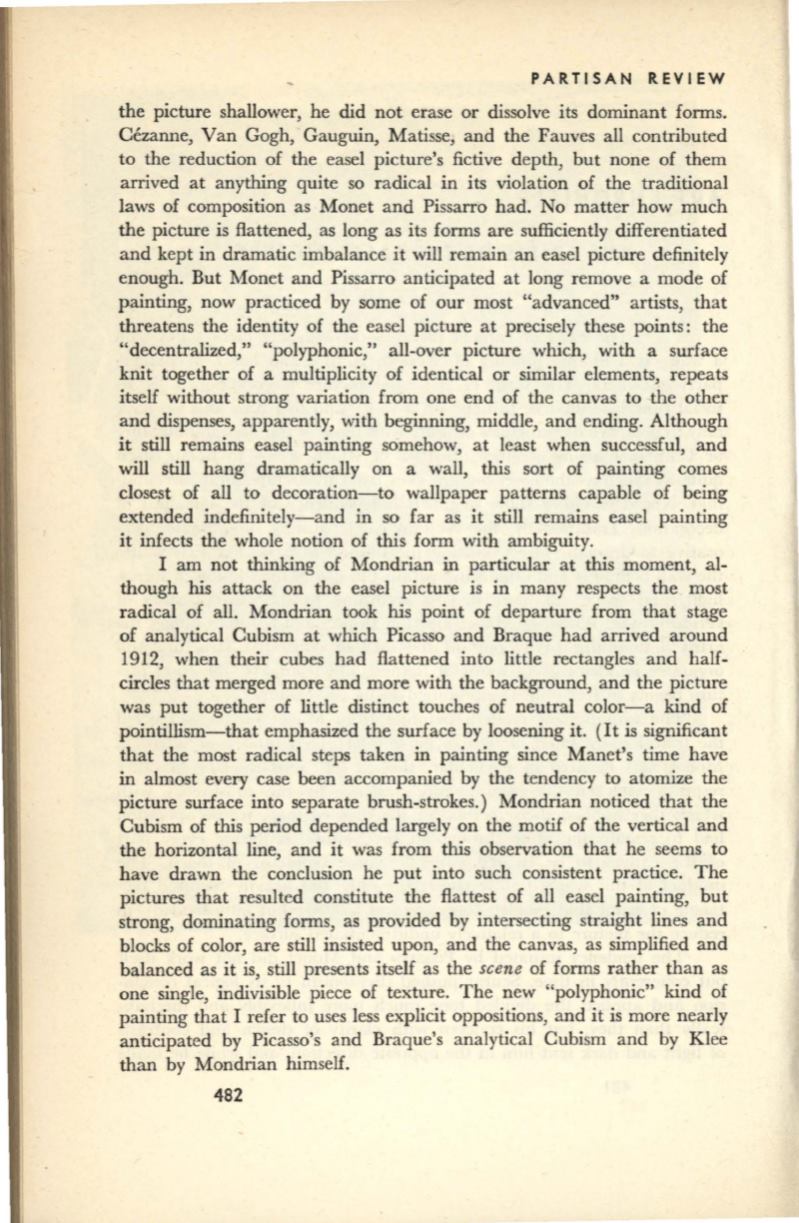
PARTISAN REVIEW
the picture shallower, he did not erase or dissolve its dominant forms.
Cezanne, Van Gogh, Gauguin, Matisse, and the Fauves all contributed
to the reduction of the easel picture's fictive depth, but none of them
arrived at anything quite so radical in its violation of the traditional
laws of composition as Monet and Pissarro had. No matter how much
the picture is flattened, as long as its forms are sufficiently differentiated
and kept in dramatic imbalance it will remain an easel picture definitely
enough. But Monet and Pissarro anticipated at long remove a mode of
painting, now practiced by some of our most "advanced" artists, that
threatens the identity of the easel picture at precisely these points: the
"decentralized," "polyphonic," all-over picture which, with a surface
knit together of a multiplicity of identical or similar elements, repeats
itself without strong variation from one end of the canvas to the other
and dispenses, apparently, with beginning, middle, and ending. Although
it still remains easel painting somehow, at least when successful, and
will still hang dramatically on a wall, this sort of painting comes
closest of all to decoration-to wallpaper patterns capable of being
extended indefinitely-and in so far as it still remains easel painting
it infects the whole notion of this form with ambiguity.
I am not thinking of Mondrian in particular at this moment, al–
though his attack on the easel picture is in many respects the most
radical of all. Mondrian took his point of departure from that stage
of analytical Cubism at which Picasso and Braque had arrived around
1912, when their cubes had flattened into little rectangles and half–
circles that merged more and more with the background, and the picture
was put together of little distinct touches of neutral color-a kind of
pointillism-that emphasized the surface by loosening it. (It is significant
that the most radical steps taken in painting since Manet's time have
in almost every case been accompanied by the tendency to atomize the
picture surface into separate brush-strokes.) Mondrian noticed that the
Cubism of this period depended largely on the motif of the vertical and
the horizontal line, and it was from this observation that he seems to
have drawn the conclusion he put into such consistent practice. The
pictures that resulted constitute the flattest of all easel painting, but
strong, dominating forms, as provided by intersecting straight lines and
blocks of color, are still insisted upon, and the canvas, as simplified and
balanced as it is, still presents itself as the
scene
of forms rather than as
one single, indivisible piece of texture. The new "polyphonic" kind of
painting that I refer to uses less explicit oppositions, and it is more nearly
anticipated by Picasso's and Braque's analytical Cubism and by Klee
than by Mondrian himself.
482


